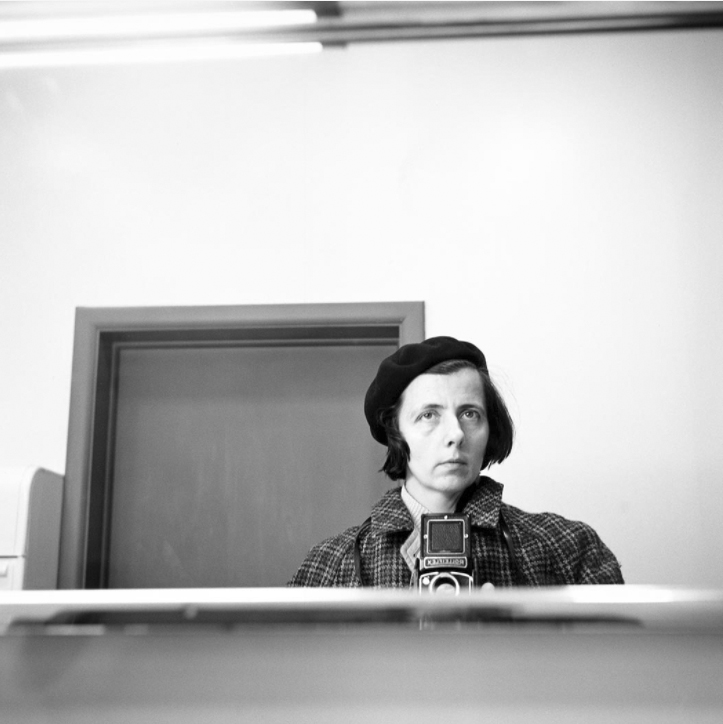What I have called the “mirror stage” …manifests the affective dynamism by which the subject primordially identifies with the visual gestalt of his own body.
Jacques Lacan
Amongst Vivian Maier’s vast photographic output is a significant number of self-portraits. Given Maier’s later reclusion, death and unacknowledged mastery of the medium, these portraits offer a melancholy irony of representation. Many of these self-portraits make use of mirrors, glass and shadow as a means of presenting the photographer; Maier depicts her shadow looming over a field of buttercups, diffracted in a bathroom mirror, and upside down in the glass reflection of a large stage light.
The French psychoanalyst, Jacques Lacan’s theories of ego and selfhood relied heavily on mirrored imagery. He defined the moment when we first acknowledge the ego and develop a self-awareness, at approximately three years old, as ‘the mirror stage.’ For Lacan this is a defining moment in our lives, a rupturing moment, when we gain an understanding of ourselves in relation to our own form and image. He writes:
‘What I have called the “mirror stage” …manifests the affective dynamism by which the subject primordially identifies with the visual gestalt of his own body.’
Lacan’s dictates offer an interesting means in which to reconsider Maier’s portraits in relation to the language of photography – the medium’s manner of representation. Self-Portrait, (1971) shows Maier’s head and upper torso reflected in the mirror of a public bathroom, lit by a strip of fluorescent lighting. The photograph explores the objectivity of the camera’s vision, with which the medium of photography has frequently been described or defined by. Simultaneously, by depicting the mechanisms through which she represents herself, with the fracturing line of the mirror cutting off the rest of her body and her camera in plain view, Maier’s image confirms the limitations of this objectivity. As the critical theorist, Roland Barthes puts it, ‘The photographic referent [is] not the optionally real thing to which an image or sign refers but the necessarily real thing which has been placed before the lens, without which there would be no photograph.’ By this logic, Maier’s self-portrait only records the presence of light to form an image of herself in the exact frame and at the very specific moment in which she pressed the shutter closed.

Self-Portrait, 1971. Vivian Maier
Her self-portraits lay bare the dichotomy of Lacan’s ‘mirror stage’. Crucial to our acknowledgment of self is the understanding of the separation of our real self who looks into the mirror and the ‘symbolic order’, or ideal self that stares back at us. Lacan describes our reflection as the ideal self by nature of its detachment from the chaos of reality and the actuality of a body. Contextualising Maier’s depictions of self in these terms lends a melancholic view; in her self-portrait reflections she is an ideal, ‘the photographer’, determined by her control over the camera, detached from the reality of her experiences of poverty and reclusion.
Lacan’s understanding of our self-recognition determines an inherent lack in the symbolic order, as our ideal is always overtaken by the truthfulness of our reality. Maier perfectly illustrates this lack in Self-Portrait, (1961), as she distorts herself in the convex mirror of a grocery store, or more significantly in Self-Portrait, Chicago, June (1976), where she presents herself simply as the shadow she casts across the pavement. The Lacanian lack is registered through the presence of her absence.
Maier depicts herself as the spectre of her own image in numerous portraits, in Self-Portrait, Chicago, October, (1977), we see her shadow set in the doorway against a tiled floor, a passer-by is also reflected in the window of the building front, creating a ghostly, surreal scene. Yet there is also a joyous playfulness to these images, in which Maier explores and extends the limitations of photographic representation. Photographs such as Self-Portrait, Chicagoland, October (1975) read as caught moments, where she finds herself reflected at odd angles, and records the registration of her own gaze. ‘The Gaze,’ another Lacanian trope is defined as the uncanny sense that the object that we look at returns the look at its own will.
In Maier’s mirrored self-portraits, the Gaze reads as a mode of self-surveillance and returns us to the paradoxical nature of the medium of photography – objectivity vs subjectivity. Her self-portraits invite questions about how we choose to present ourselves and the reality of that presentation but most importantly they ask, what does it mean to represent oneself?
(By Alexandra MacKay)
